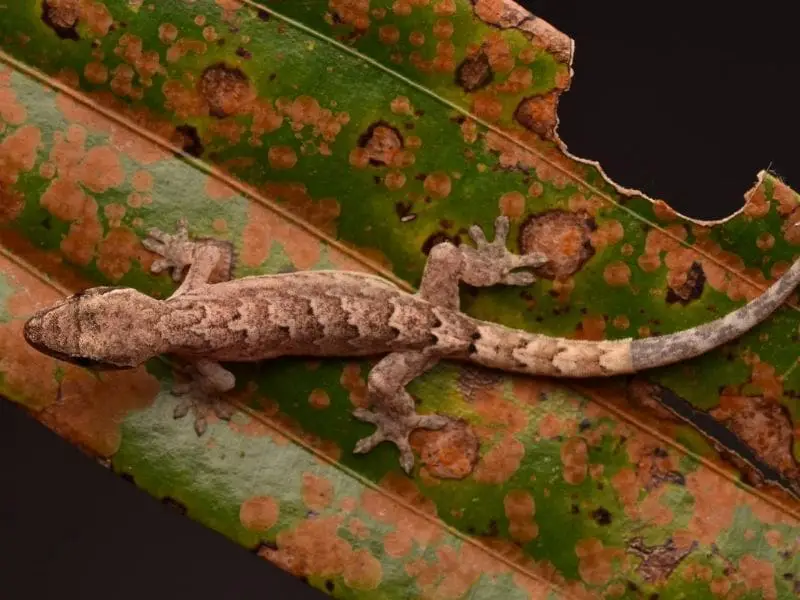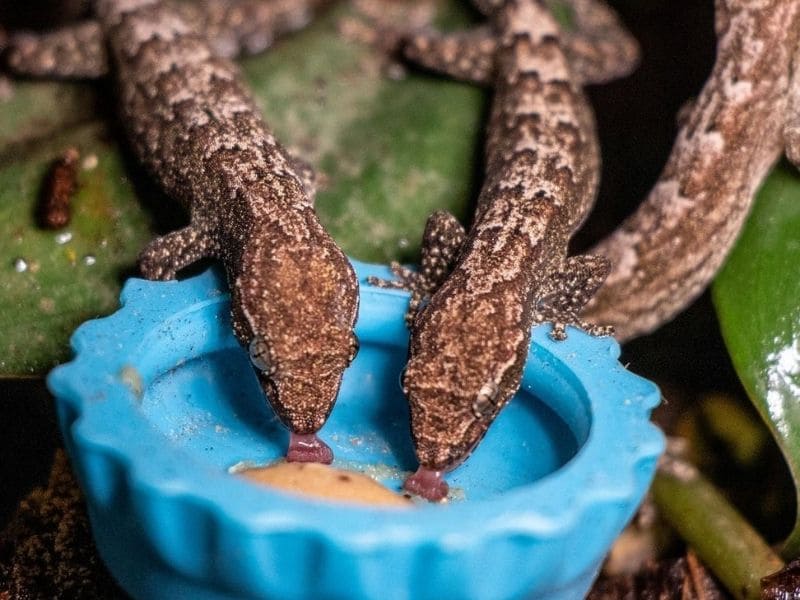The mourning gecko enclosure is an important part of a mourning gecko’s care. There are many factors that determine the size of the enclosure for mourning geckos, including their age, weight and type.
The first step to setting up a mourning gecko’s new home is choosing the right one. In this article we will go through all of these steps in order to provide you with everything you need for your pet.
How do you house mourning a gecko?

You can house a mourning gecko by providing the following conditions in its enclosure:
Size of the enclosure
The perfect size of the enclosure for a mourning gecko is between 8 and 10 inches wide by 12 to 16 inches tall.
Mourning geckos need plenty of room to climb, eat plants, hide from predators and more. The size can vary depending on what type of mourning gecko you have as well as if there are multiple geckos in one container.
Large containers such as plastic storage bins should be avoided because they do not allow enough air flow or light into the habitat which could cause health issues with your pet.
Enclosure substrate
As for the substrate, there are many options. One of the most popular is Eco Earth, which has a lot of great qualities for mourning geckos to explore and play on. Its benefits include:
- It can be found at pet stores like Petsmart and Petco.
- The substrate consists mostly of coconut fiber, peat moss, ground bark chips (pine), charcoal powder.
- There’s no risk that your animal will ingest any toxic substances from this kind of substrate because it doesn’t contain any fertilizers or chemicals.
Since there are so many different substrates out there you might want to experiment with them all to see what works best for your needs. You may find that one type suits their taste better than others.
Whatever substrate you choose just make sure it is safe for your geckos.
Otherwise, they may suffer from impaction which is when a gecko ingests a substrate and it blocks their intestinal tracts.
If you want to give your geckos something to explore in the enclosure, then I suggest adding different shapes of rocks or tree roots. You can also get some coco coir logs.
The mourning gecko prefers to live on a substrate with plenty of places for them to hide from predators while still having access to things like ground bark chips (pine), charcoal powder, coconut fiber, peat moss.
These substrates usually don’t have any fertilizers or chemicals so there is no risk that they will ingest anything toxic. There are many types out there. Just keep trying until you find the right one for your type of gecko.
Water
Geckos too need water to stay hydrated and for their health.
There are a number of ways to provide water in the enclosure, including spraying down plants or rocks using an automated mister-type device, drilling a hole near the ground level with access from below into which you can fill up a dish with water (or stones) that will gradually seep out through the bottom surface over time as needed.
You may also use shallow saucers or bowls on top of larger ones so moisture doesn’t evaporate too quickly.
Humidity
Mourning geckos require a humid environment. The humidity level should be maintained at 60 to 70%.
This can be accomplished through a number of ways, such as misting the enclosure or by using moistened substrate materials. A hygrometer is an excellent tool to use for monitoring and maintaining the correct humidity levels in your gecko’s habitat.
Temperatures
Your mourning gecko’s temperature should be between 70- and 80- degrees Fahrenheit. Your mourning gecko will need a slightly higher temperature at night, hence the need to provide heat with a bulb (about 40 watts placed at the top of the enclosure is enough).
It is important not to expose your mourning gecko too long or consistently to temperatures that are below 70°F because it can cause the animal stress and lead them into brumation which means they stop eating, moving around as much, and become inactive for months on end.
They may also experience an increased risk of illness during this time period so please make sure you monitor their activity closely if they start going through periods where they don’t eat very often.
Fluorescent light
Mourning geckos don’t need a lot of light, but they do need UVB exposure to synthesize Vitamin D. If there is insufficient natural sunlight, you can solve this problem by using fluorescent tubes (i.e., T-12 or equivalent). Fluorescent lights should be placed near the top and back wall of a cage that has been modified with mesh wire screening on all sides and top for optimal viewing by humans as well as the gecko.
Make sure you use a mercury vapor bulb in conjunction with any fluorescent bulbs you may have hanging from your walls so that it will provide proper lighting without emitting too much heat which could end up burning your little guy if he decides to sun himself at night when temps are cooler outside.
Cannibalism
Mourning geckos can eat each other. Geckos that are not breeding, or have been removed from a group for medical reasons might be more likely to cannibalize other geckos in the enclosure. Cannibalism is sometimes observed during fighting and at feeding time when multiple geckos are put into an enclosure with one food dish. You can prevent this by the following measures:
- Provide enough space in the tank so each gecko has its own territory and no need to fight over territory (this can lead to fighting which may result in cannibalizing).
- If you see two of your mourning geckos eating one another, remove them from the cage immediately. The last thing you want is any species going extinct because they cannot find someone else who shares their genes. There’s nothing wrong with providing additional hiding places.
They can also eat the young ones and the eggs too. This type of cannibalism can be prevented as follows:
- Provide a variety of both live and non-live foods.
- Place the geckos in an enclosure with other mourning geckos that share their genetic background to reduce chances of cannibalism.
- Always use caution when separating geckos from one another; it is best not to physically move them unless absolutely necessary as they may fight or be injured during the process. It’s much better for everyone if you just provide more space, food, and hiding places instead.
- Once born, keep the young ones away until they become juveniles then you can reintroduce them into the main cage.
This will prevent cannibalism among your pet lizards.
Diet

Your mourning gecko feeds on invertebrates, which are mainly insects. You can feed your mourning gecko with crickets and mealworms that you buy from a pet store. They also feed on certain plants.
A good way to provide fresh food is by using live plants in their cages as they will attract bugs for them to eat. One type of plant that works best is gerbera daisies because it attracts large amounts of flies and other small flying insects such as moths or beetles.
Some breeds may need more protein than others, so if you notice your animal is seeking out calcium supplements or eating strange things then try adding an occasional cricket or worm into its diet.
Mourning geckos also need supplements such as Vitamin D, calcium, and vitamin C.
You can sometimes buy pre-mixed supplements at pet stores if you don’t have the time or knowledge to mix up your own.
A good way to provide fresh food is by using live plants in their cages as they will attract bugs for them to eat. You can also dust the insects you give them so that they can eat the insects with the supplements.
Breeding
It’s quite easy to breed mourning geckos. Simply keep two males and one female in an enclosure together to breed them; they will be able to reproduce as long as there is enough space and food for all three geckos.
The females should only lay eggs during spring months (roughly March through June), while the male must wait until summer/fall before he’s reproductive again. This means that it’s easy to tell when females are laying eggs by looking at their weight: if she has lost weight recently, then she may have laid her clutch already or is about ready to do so soon.
They are also pathenogenetic meaning that they will lay eggs without mating, but if you want to breed them for color variety or species preservation they should be mated.
The female will usually dig a hole in the soil and lay her eggs one by one inside of it before covering them up with dirt.
Eggs can take anywhere from five weeks to six months to hatch. Once babies have reached about three inches (approximately four years old) they are fully mature adults capable of reproducing themselves if given the opportunity at the right time.
Living together with other geckos or pets
Mourning geckos can live together with other geckos or pets. Be sure to have a large enough enclosure for all of the animals live comfortably together without being overcrowded, and provide them with plenty of hiding spots where they can feel safe at night.
They can also live with other types of pets, such as dart frogs. However, keep in mind that they are a different species and will not necessarily understand each other’s needs or wants.
Mourning geckos can live together with others of their own kind without fighting. You just have to make sure there is enough room for them to feel comfortable (about four square feet per adult mourning gecko). They do need space so don’t overcrowd your enclosure.
If you plan on having more than one male, be aware that males sometimes fight until the weaker lizard gives up his territory and leaves the area entirely. The best way to avoid this problem is by providing plenty of hiding spots where females can stay away from aggressive males when necessary.
Males also tend to roam around their cages and will probably find and attack other male geckos if you put them in the same enclosure.
Mourning gecko enclosures can be as simple or elaborate as desired, but it is important to have plenty of hiding spots for your mourning geckos so they stay happy and healthy.
##Aggression
Mourning geckos can also get territorial and aggressive with other mourning geckos. As such, provide a large enough enclosure for them to stretch their legs on the ground without feeling cramped. Maintain at least one-inch of substrate depth in your enclosure so they have plenty of room for burrowing when desired or necessary. Be sure that there are no sharp edges or anything that might harm them as well.
The key to preventing aggression is providing each animal its own space within the same environment, which may mean two cages (or an aquarium) instead of just one if you want these lizards living together peacefully inside your home. It’s also important not only to provide adequate space but to also provide enough of the right kind of substrate.
If you’re housing two mourning geckos together, provide at least one hiding spot per animal inside your enclosure. Remember, these lizards are active during both day and night. They may feel more secure with multiple hiding spots within an enclosed area where there is limited visibility from other animals outside the cage (or aquarium).
If aggression persists as it often does in male/female mourning geckos, it is best to separate the geckos into their own space within the same environment, which may mean two cages (or an aquarium) instead of just one if you want these lizards living together peacefully inside your home.
